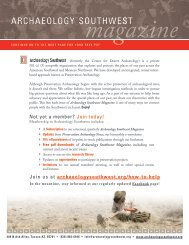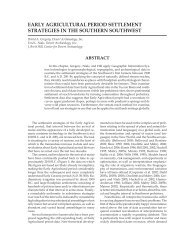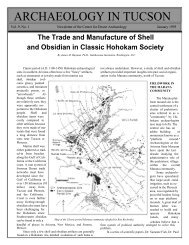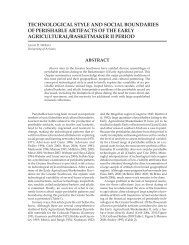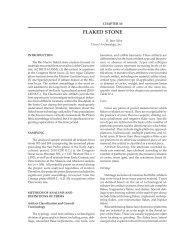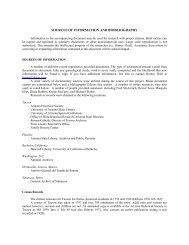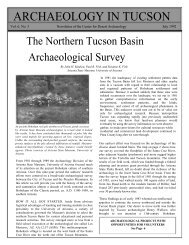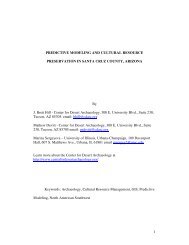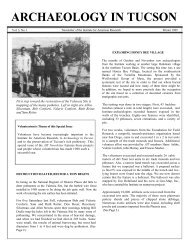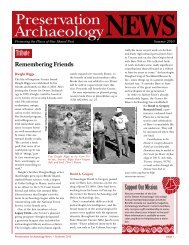NEWS - The Center for Desert Archaeology - Southwest...
NEWS - The Center for Desert Archaeology - Southwest...
NEWS - The Center for Desert Archaeology - Southwest...
Create successful ePaper yourself
Turn your PDF publications into a flip-book with our unique Google optimized e-Paper software.
Preservation <strong>NEWS</strong><br />
<strong>Archaeology</strong><br />
Building a Preservation <strong>Archaeology</strong> Network across the Greater <strong>Southwest</strong> Fall 2009<br />
Viewpoint<br />
<strong>The</strong> Mule Creek<br />
Archaeological<br />
Testing Project<br />
<strong>Center</strong> Preservation Fellow and Field Supervisor<br />
Rob Jones compiled this report on our<br />
recent fieldwork in Mule Creek, New Mexico.<br />
This past June, the <strong>Center</strong> returned to<br />
southwestern New Mexico <strong>for</strong> our second<br />
season of fieldwork in partnership<br />
with Hendrix College and<br />
several local landowners. Brett<br />
Hill, Field Director and Hendrix<br />
College Professor, brought<br />
seven students to Mule Creek,<br />
where we were graciously<br />
accommodated on Susan and<br />
Alex Jerome’s ranch.<br />
This year, we focused on<br />
two previously undocumented<br />
sites, Gamalstad and Fornholt.<br />
Both include occupations that<br />
date after the relatively well-<br />
known Mimbres Classic period<br />
(A.D. 1000–1150). <strong>The</strong> principal<br />
goal of our excavations was<br />
to obtain in<strong>for</strong>mation on site<br />
chronology, cultural affiliation, and basic<br />
economic activities in the Salado period<br />
(A.D. 1300–1450). <strong>The</strong>re were a few surprises<br />
at the Fornholt site, which appears<br />
to be a substantial masonry pueblo dating<br />
between the Mimbres Classic period and<br />
the Salado period. We also revisited the<br />
3-Up site and excavated a deep test unit<br />
that should help us better understand the<br />
occupation history of this important site.<br />
We look <strong>for</strong>ward to completing current<br />
analyses and beginning the process of<br />
integrating what we learned with what we<br />
already know about Salado communities<br />
in the late prehistoric <strong>Southwest</strong>. We’re<br />
<strong>for</strong>tunate to be welcome in an area with<br />
compelling archaeology and generous<br />
community support. This past summer’s<br />
fieldwork gave us a wealth of new data<br />
to work with, and we plan to present our<br />
findings in a variety of venues over the<br />
next year as we move toward synthesis.<br />
Several of our team members prepared<br />
these up-to-the-minute reports <strong>for</strong> you.<br />
Rob Jones, Field Supervisor and Preservation<br />
Fellow:<br />
This season’s work yielded a wealth of<br />
obsidian samples from varying time<br />
periods, which will allow me to examine<br />
Mule Creek obsidian use through time.<br />
Rob Jones discusses excavation strategy with students and local<br />
guests on the Fornholt site in Mule Creek.<br />
<strong>The</strong> students quickly tired of pulling tiny<br />
black projectile points from the screen—I<br />
insisted that this was not usually a boring<br />
event! <strong>The</strong>re are several distinct obsidian<br />
sources in Mule Creek, and I am interested<br />
in quantifying and understanding<br />
differences in nodule size and use in the<br />
valley. A variety of local samples is, there<strong>for</strong>e,<br />
quite useful. I continue to identify<br />
obsidian in museum collections so that<br />
I can map how far Mule Creek obsidian<br />
moved across the ancient southwestern<br />
landscape and—hopefully—identify who<br />
controlled its movement. Along with an<br />
analysis of local lithic technologies, this<br />
should contribute to our understanding<br />
of community relationships and social<br />
networks in the area. For now, I have a<br />
rather large stack of broken rocks to analyze,<br />
so I plan on living in the <strong>Center</strong> lab<br />
<strong>for</strong> the next few months...<br />
Deb Huntley, Preservation Archaeologist:<br />
I spent a lot of my summer visiting<br />
museum collections in New Mexico, primarily<br />
the Laboratory of Anthropology<br />
in Santa Fe and the Maxwell Museum in<br />
Albuquerque. My main goal was to track<br />
down collections from a number of Upper<br />
Gila sites excavated in the 1960s and<br />
1970s. After sorting through many, many<br />
boxes—with Katherine Dungan’s<br />
help—I can safely say I’ve seen<br />
about 90% of the existing sherds<br />
from the area! I’ve also selected<br />
a sample of more than 200<br />
sherds to submit <strong>for</strong> compositional<br />
analysis, which will help<br />
us track pottery production<br />
and circulation in the region.<br />
Important <strong>for</strong> our research as<br />
well is my observation that<br />
many sherds in these museum<br />
collections were originally identified<br />
as Gila Polychrome, but<br />
today would be classified as Cliff<br />
continued on page 2<br />
Our Vision<br />
Polychrome, one of the later<br />
types in the Salado polychrome<br />
series.<br />
At the <strong>Center</strong> <strong>for</strong> <strong>Desert</strong> <strong>Archaeology</strong>,<br />
we envision a society in which the<br />
places of the past are valued as the<br />
foundations <strong>for</strong> a vibrant future. As such, it is<br />
our mission to preserve the places of our<br />
shared past. We undertake this mission on<br />
behalf of those who find meaning in such<br />
places—and we deeply appreciate your<br />
partnership in this endeavor!<br />
Preservation <strong>Archaeology</strong> News • Fall 2009 page 1
<strong>Center</strong> <strong>for</strong> <strong>Desert</strong> <strong>Archaeology</strong><br />
300 E. University Blvd., Ste. 230<br />
Tucson, AZ 85705<br />
(520) 882-6946<br />
(520) 882-6948 (fax)<br />
center@cdarc.org<br />
www.cdarc.org<br />
Board of Directors<br />
Al Arpad<br />
Peter Boyle<br />
Demion Clinco<br />
William H. Doelle<br />
Diana Hadley<br />
Bernard Siquieros<br />
Benjamin Smith<br />
Donna Tang<br />
Advisory Board<br />
Hester Davis<br />
Don Fowler<br />
William D. Lipe<br />
Margaret Nelson<br />
William J. Robinson<br />
James Snead<br />
Elisa Villalpando<br />
Staff<br />
Jeffery J. Clark, Ph.D., Preservation<br />
Archaeologist<br />
Jacquie M. Dale, M.A., Preservation<br />
Archaeologist<br />
Mathew Devitt, M.A., Preservation<br />
Archaeologist and Digital Media<br />
Specialist<br />
Douglas W. Gann, Ph.D., Preservation<br />
Archaeologist and Digital Media<br />
Specialist<br />
David A. Gregory, M.A., Preservation<br />
Archaeologist<br />
Deborah L. Huntley, Ph.D., Preservation<br />
Archaeologist<br />
Rob Jones, M.A., Preservation Fellow<br />
Andy Laurenzi, M.S., Field<br />
Representative<br />
Debra L. Lee, Office Manager<br />
Matthew Pailes, B.A., Preservation<br />
Archaeologist<br />
Linda J. Pierce, M.A., Programs<br />
Manager<br />
Paul F. Reed, M.A., Preservation<br />
Archaeologist<br />
Kate Sarther Gann, M.A., Membership<br />
Coordinator<br />
Tobi Taylor, M.A., Content Editor,<br />
<strong>Archaeology</strong> <strong>Southwest</strong><br />
James M. Vint, M.A., Preservation<br />
Fellow<br />
Aaron Wright, M.A., Preservation Fellow<br />
Research Associates<br />
Richard Flint, Ph.D.<br />
Shirley Cushing Flint, M.A.<br />
J. Brett Hill, Ph.D.<br />
Patrick D. Lyons, Ph.D.<br />
Viewpoint continued from pg 1<br />
Katherine Dungan, Field Supervisor and Research<br />
Assistant:<br />
Over the past year, I’ve worked with Deb to analyze<br />
the ceramics we recovered last summer. Our<br />
analysis shows clear differences between two<br />
areas of the 3-Up site. One of these areas<br />
suggests a late 13th-century migration of<br />
people with roots in the Kayenta tradition<br />
of northern Arizona. <strong>The</strong> other suggests a<br />
later migration of people who also show<br />
Kayenta ancestry, but had already become<br />
part of the tradition in which Salado polychromes<br />
were the decorated pottery of<br />
choice. Ceramics from earlier time periods<br />
at 3-Up indicate that the new arrivals<br />
might not have moved into an uninhabited<br />
frontier. We’ve just started analyzing the<br />
ceramics from this year’s excavations, but<br />
in time, we should have a much better<br />
idea of what was happening at 3-Up and<br />
elsewhere in Mule Creek when the immigrants<br />
arrived.<br />
Jeff Clark (Preservation Archaeologist)<br />
and Brett Hill (Research Associate), Project<br />
Directors:<br />
Research in Mule Creek and the Upper<br />
Gila region continues the <strong>Center</strong>’s longterm<br />
ef<strong>for</strong>t to better understand the<br />
demography of Salado populations living<br />
in the southern <strong>Southwest</strong> in the centuries<br />
prior to the arrival of Europeans.<br />
Following archaeologist Emil Haury, we<br />
believe that the Salado phenomenon<br />
represents a complex hybridization of<br />
northern and southern native groups<br />
in the wake of widespread upheaval<br />
during the late 13th century. Our earlier<br />
study of ceramic, obsidian, and settlement<br />
patterns documented the <strong>for</strong>mation of<br />
multicultural communities and at least<br />
one diasporic community that linked<br />
dispersed Kayenta immigrants from northeast<br />
Arizona.<br />
Preliminary results from our two field<br />
seasons indicate that Mule Creek was<br />
occupied continuously by substantial<br />
populations from at least the early<br />
Mimbres period through the Salado<br />
period (circa A.D. 800–1450). We now<br />
have evidence that the area was probably<br />
inhabited when Kayenta immigrants began<br />
arriving in the late 1200s.<br />
<strong>The</strong> dominant area of Kayenta settlement<br />
appears to be the 3-Up site, where<br />
large concentrations of pottery closely associated<br />
with these immigrants were recovered. Subsequent<br />
14th-century components were identified at 3-<br />
Up and Gamalstad, with the strongest presence<br />
at 3-Up. Large quantities of Salado polychrome<br />
pottery—including Cliff Polychrome and other<br />
recently identified late types—were found at 3-Up.<br />
<strong>The</strong> greatest concentrations of these late types<br />
were found at a small, isolated locus 400 meters<br />
upstream from the main occupation.<br />
Top: Katherine Dungan (left) and Judy Crockett hike up a hillside<br />
made of obsidian near Mule Creek, New Mexico. Middle:<br />
During our Chaco Canyon field trip, Paul Reed led us to the<br />
Pueblo Bonito overlook. Bottom: Lindsay Romaniello (left)<br />
and Seth Boren lay out a test unit under the instruction of Rob<br />
Jones.<br />
Preservation <strong>Archaeology</strong> News • Fall 2009 page 2
Become Acquainted<br />
Susan Jerome<br />
Susan and Alex Jerome graciously hosted<br />
the 2009 preservation archaeology field<br />
school at their Rocker Diamond X Ranch<br />
in Mule Creek, New Mexico.<br />
I understand that you and<br />
Alex are not originally from<br />
this area. What drew you<br />
here? How would you describe<br />
your connection to this place?<br />
As Midwesterners, we longed<br />
to escape harsh winters, so we<br />
began a studied search <strong>for</strong> just<br />
the right spot in the <strong>Southwest</strong>.<br />
In fact, be<strong>for</strong>e we were married,<br />
Alex gave me a New Mexico<br />
flag—a not-too-subtle hint! We<br />
took a long road trip in 1983,<br />
with some definite ideas and<br />
expectations of what we were<br />
looking <strong>for</strong>. After a disappointing<br />
sojourn around the more<br />
southern areas of the state, we<br />
decided on a whim to check out<br />
Silver City. That led us to a real<br />
estate agent who ferried us out to Mule<br />
Creek. It was mid-May, but already green;<br />
a passing thunderstorm left a double rainbow,<br />
there were hummingbirds cavorting in<br />
the meadows, and the creek was laughing<br />
down its course. I felt I’d come home, and<br />
so did Alex.<br />
Susie Jerome.<br />
What do you value most about life in this<br />
community?<br />
<strong>The</strong>re is a great deal of space and freedom.<br />
Our community is becoming more diverse<br />
and populated, but there is tolerance, if<br />
not full acceptance, of differing lifestyles.<br />
Neighbors still help neighbors, and there<br />
is an almost built-in neighborhood watch<br />
attitude about taking care of each other.<br />
Of course, there is a great deal of scrutiny<br />
as well, but overall, the lack of anonymity<br />
is compensated by community support <strong>for</strong><br />
the individual.<br />
At present, Mule Creek is going through<br />
some growing pains. We are beginning to<br />
consider concepts such as “common good”<br />
and wrestle with the implementation of<br />
projects like a fire station and restoration of<br />
the community center.<br />
How did you become interested in protecting<br />
and preserving archaeological sites in<br />
this region?<br />
As a child, I was fascinated with all things<br />
archaeological, especially Native American<br />
cultures. A friend of my mother who had<br />
been a professional archaeologist in the<br />
American <strong>Southwest</strong> sent me books that I<br />
treasured.<br />
Shortly after we moved here, some landowners<br />
nearby began digging a ruin with<br />
heavy equipment.<br />
<strong>The</strong>ir<br />
activity became<br />
more frenzied as<br />
the 1988 enactment<br />
date of the<br />
amendments to<br />
ARPA [Archaeological<br />
Resources<br />
Protection Act]<br />
approached,<br />
until they were<br />
using flood<br />
lights at night to<br />
unearth whatever<br />
they could<br />
with a backhoe.<br />
We were horrified,<br />
and their<br />
attitude about<br />
the sites being just another ranch resource<br />
was hard to grasp. I was particularly concerned<br />
about the destruction of the record<br />
in situ. Parcel by parcel, we have been able<br />
to purchase this site and the remainder<br />
of its related, undisturbed land, as well as<br />
another site.<br />
Because our val-<br />
ley is so picturesque<br />
and desirable<br />
to retirees<br />
and developers,<br />
we are concerned<br />
that the<br />
area is at risk.<br />
As a one-time<br />
community organizer and volunteer<br />
teacher, what are some of your thoughts<br />
on how the <strong>Center</strong> can contribute to preservation<br />
in this region?<br />
Conveying the idea that Mule Creek archaeological<br />
sites are unique and fascinating,<br />
but fragile, is essential. Presenting current<br />
research in an accessible <strong>for</strong>mat and inviting<br />
community input will help build relationships.<br />
Just as illicit pot hunters exploit<br />
By considering landowners as true<br />
stewards and principal partners,<br />
archaeology extends a respectful<br />
hand in friendship.<br />
archaeological remains <strong>for</strong> economic<br />
gain, there is a risk that viewing current<br />
residents as mere conduits to achieving<br />
academic and professional goals will stymie<br />
archaeological preservation. By considering<br />
landowners as true stewards and principal<br />
partners, archaeology extends a respectful<br />
hand in friendship. By advocating incentives<br />
<strong>for</strong> preservation actions which benefit<br />
the landowner, I believe the <strong>Center</strong> can be<br />
instrumental in <strong>for</strong>ging trust and the ongoing<br />
dialogue required to preserve these<br />
treasures. Booths at the county fair, school<br />
visits, and presentations at the community<br />
center are a few ideas.<br />
Despite the awesome natural beauty of<br />
the region, there is significant economic<br />
deprivation and unemployment that further<br />
endangers prehistoric sites. Helping<br />
this area make up <strong>for</strong> losses in ranching<br />
and mining revenues through sustainable<br />
small businesses or eco-tourism are other<br />
areas where outside expertise might have<br />
something to offer.<br />
Along the same lines, what is your own<br />
vision <strong>for</strong> the future of research and<br />
learning in this special place?<br />
We have been so <strong>for</strong>tunate to be the caretakers<br />
of this place! Everyday, I listen to<br />
the traffic report in Phoenix on the truck<br />
radio while I check on my cattle, and I realize<br />
what a precious sanctuary we have here.<br />
Alex and I have long thought about<br />
what great learning opportunities exist<br />
here, <strong>for</strong> all age groups. In addition to the<br />
archaeological sites, we have two riparian<br />
areas and a lot of<br />
wildlife. We are<br />
—Susan Jerome<br />
also interested<br />
in earth building<br />
and promoting<br />
those techniques.<br />
Because we have<br />
reconnected several<br />
parcels in the<br />
valley, we have<br />
an assortment<br />
of accommodations <strong>for</strong> small groups. Our<br />
experience in hosting the field school this<br />
summer has us thinking about partnering<br />
with several institutions to further learning<br />
access to the ranch. By carefully designing<br />
the organizational structure and facilities,<br />
we can offer an experience to many learners<br />
even after we’re gone. We can’t think of<br />
a better legacy than to share this conscientiously<br />
with the future.<br />
Preservation <strong>Archaeology</strong> News • Fall 2009 page 3
300 E. University Blvd., Ste. 230<br />
Tucson, AZ 85705<br />
Mark the Date<br />
October 3,<br />
Pieces of the Puzzle<br />
Participate<br />
Events and<br />
Opportunities<br />
n Phoenix-area residents<br />
and visitors, please join the<br />
<strong>Center</strong> at Pueblo Grande<br />
Museum <strong>for</strong> a celebration<br />
commemorating the closing of<br />
Pieces of the Puzzle: New Perspectives<br />
on the Hohokam. <strong>The</strong><br />
gathering, which will include<br />
refreshments and a presentation<br />
by <strong>Center</strong> Preservation<br />
Archaeologist Deb Huntley,<br />
will take place on Saturday,<br />
October 3, at 2:00 p.m. Deb’s<br />
talk is entitled Life on the Frontier:<br />
Looking <strong>for</strong> the Salado in<br />
<strong>Southwest</strong>ern New Mexico.<br />
n Were you inspired by Preserving<br />
Missions in the Pimería Alta, the most<br />
recent issue of <strong>Archaeology</strong> <strong>Southwest</strong>?<br />
Why not take a Kino Mission Tour<br />
and experience these Spanish Colonial<br />
churches in person, guided by expert<br />
historians and anthropologists? <strong>The</strong><br />
three-day tours introduce you to eight<br />
communities in Sonora, Mexico, and<br />
On September 1, <strong>Archaeology</strong> Café participants and panelists<br />
shared insights on the future of the Tucson Origins Project.<br />
are sponsored by the educational nonprofit<br />
<strong>Southwest</strong>ern Mission Research<br />
<strong>Center</strong>. More in<strong>for</strong>mation and dates <strong>for</strong><br />
fall and spring through 2012 may be<br />
found at www.southwestmissions.org.<br />
Non-Profit<br />
Organization<br />
U.S. Postage<br />
PAID<br />
Tucson, AZ<br />
Permit No. 878<br />
n Dr. James T. Watson, Assistant<br />
Curator of Bioarchaeology at the Arizona<br />
State Museum, will speak on <strong>Desert</strong>s,<br />
Diets, and Dentition: How the Introduction<br />
of Agriculture Affected<br />
Ancient Oral Health at the October<br />
6 meeting of <strong>Archaeology</strong> Café.<br />
Our program begins at 6:00 p.m.<br />
at Casa Vicente, 375 S. Stone Ave.,<br />
Tucson. Settle in with tapas and<br />
a beverage, and make some new<br />
friends at one of these lively, in<strong>for</strong>mal<br />
events.<br />
n Are you a member of the<br />
<strong>Center</strong>? If not, we invite you to join<br />
us and take advantage of outstanding<br />
benefits, which include our<br />
award-winning quarterly maga-<br />
zine, <strong>Archaeology</strong> <strong>Southwest</strong>, discounts<br />
in our online bookstore, and<br />
invitations to special events. Memberships<br />
begin at $25 per year, and we<br />
also have a convenient monthly giving<br />
option that increases your gift’s impact.<br />
Contact Kate Gann at (520) 882-6946, or<br />
join online at www.cdarc.org.<br />
Preservation <strong>Archaeology</strong> News • Fall 2009 page 4



